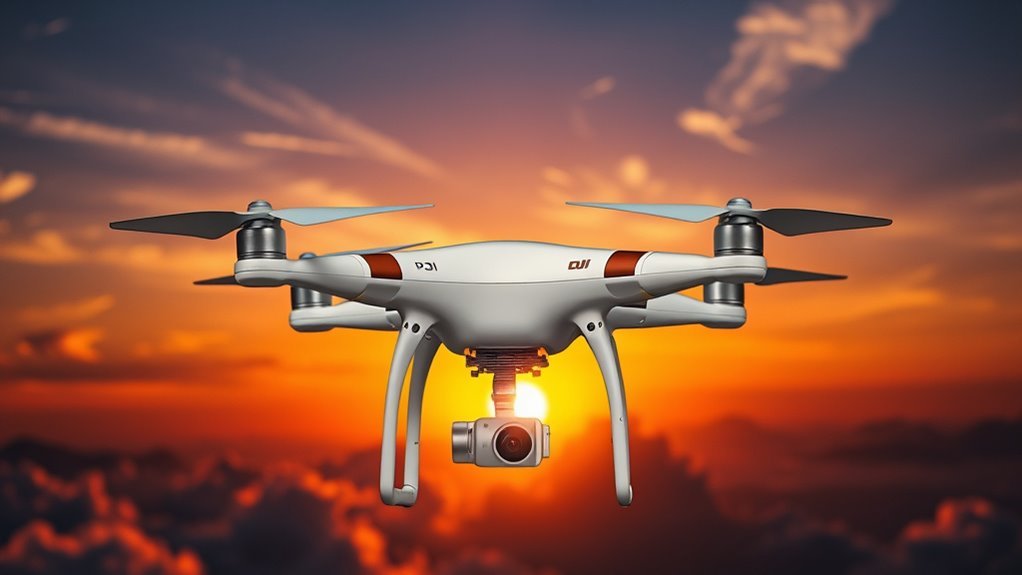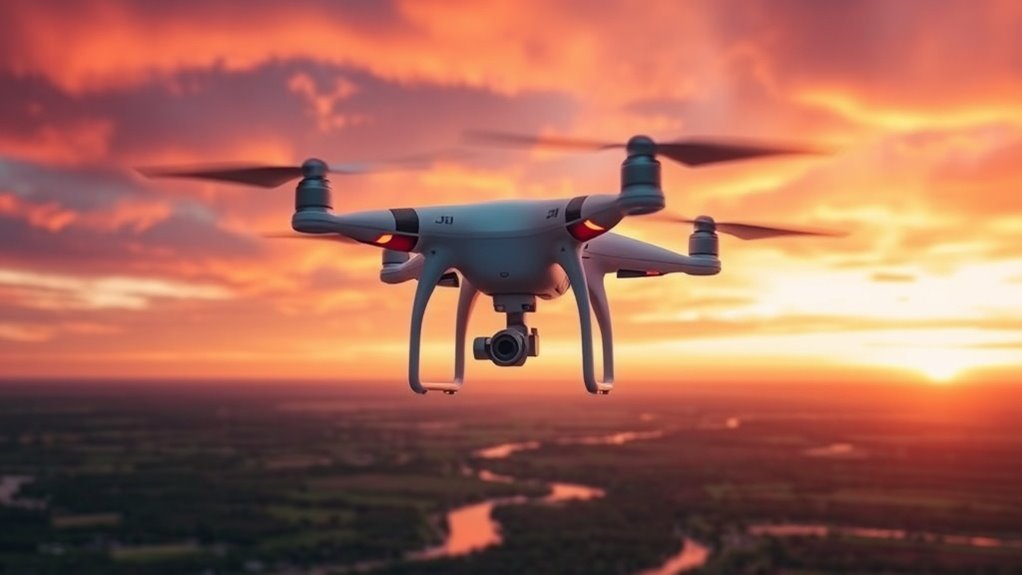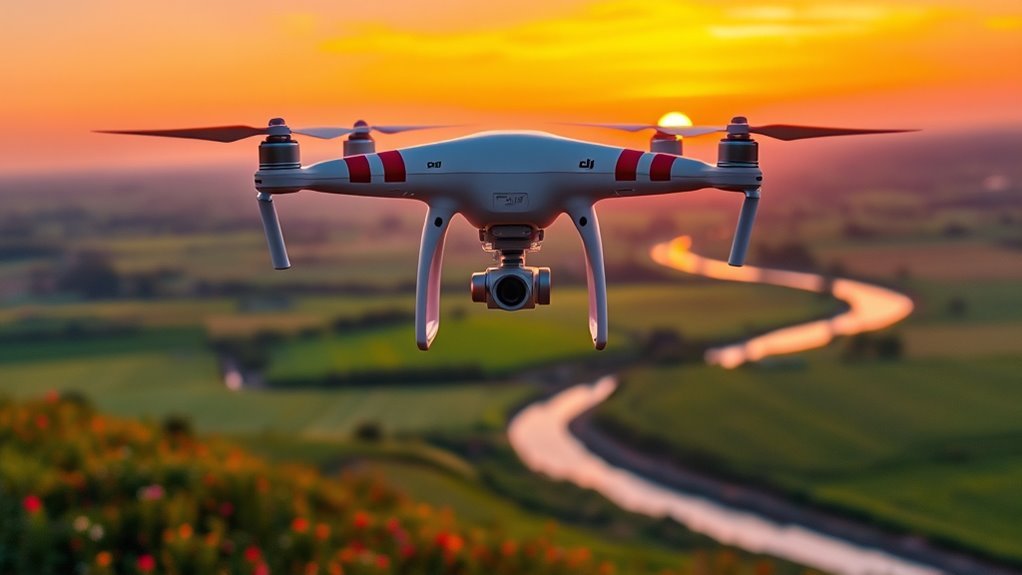If you choose the DJI Phantom 4 Camera Drone, you’ll appreciate its sturdy, aerodynamic design and 20MP 1-inch sensor delivering sharp, dynamic aerial shots. It offers stable flights with advanced altitude control and strong wind resistance, plus intuitive intelligent modes like ActiveTrack for effortless navigation. You’ll get about 28 minutes of flight time with efficient charging. Its robust signal and obstacle avoidance enhance safety and control. Explore further to see how these features balance performance and value for your needs.
Design and Build Quality

The design of the DJI Phantom 4 reflects a balance between functionality and durability, ensuring it can withstand various flying conditions while remaining user-friendly. When you examine its drone aesthetics, you’ll notice a sleek, aerodynamic form that minimizes air resistance, enhancing flight stability and efficiency. Its build durability is evident in the use of high-quality composite materials, which provide robust protection against impacts and vibrations without adding unnecessary weight. The thoughtfully engineered frame supports quick assembly and disassembly, catering to your need for mobility and freedom during outdoor adventures. This design approach allows you to focus on flying rather than worrying about equipment fragility, making it a reliable companion whether you’re a hobbyist or a professional seeking versatile aerial exploration.
Camera Specifications and Image Quality

Although many drones offer impressive specs, DJI Phantom 4 stands out with its 1-inch 20-megapixel sensor, which captures high-resolution images with remarkable clarity and dynamic range. You’ll appreciate its ability to produce detailed photos, even when shooting complex scenes. The drone’s advanced image stabilization system minimizes motion blur, ensuring crisp shots during flight. This stabilization, combined with the sensor size, enhances overall image quality, especially when capturing fast-moving subjects or windy conditions. Low light performance is particularly strong, allowing you to shoot in challenging lighting without excessive noise or loss of detail. For those who value creative freedom in aerial photography, the Phantom 4’s camera capabilities provide consistent, professional-grade results, empowering you to capture stunning visuals no matter where your adventures take you.
Flight Performance and Stability

When you pilot the DJI Phantom 4, you’ll notice its exceptional flight performance and stability, which are essential for capturing smooth, professional-quality footage. The drone’s advanced altitude control guarantees precise hovering, even in complex environments. Its robust wind resistance capabilities allow you to maintain steady flight in breezy conditions, giving you the freedom to explore without constant adjustments. Key flight performance features include:
- Responsive controls that translate your commands seamlessly.
- Intelligent sensors that prevent sudden drops or drifts.
- Stable hovering that supports crisp video capture.
- Efficient battery management that sustains longer flights.
These elements collectively provide a reliable and confident flying experience, empowering you to focus on creativity rather than battling the elements or mechanical unpredictability.
Intelligent Flight Modes
Since mastering complex maneuvers can be challenging, DJI Phantom 4 offers a range of intelligent flight modes that simplify control and enhance your creative options. These modes leverage intelligent routing algorithms to maintain smooth, precise movements without constant manual input. Automated tracking allows the drone to lock onto and follow subjects dynamically, freeing you from pilot duties and enabling you to focus on framing your shot. Modes like ActiveTrack and TapFly demonstrate how the Phantom 4 anticipates your intentions, steering around obstacles while maintaining stable flight paths. This intelligent flight technology not only reduces the learning curve but also expands your freedom to capture cinematic footage effortlessly. Overall, these capabilities transform drone operation into an intuitive experience, balancing autonomy with user control for more confident aerial creativity.
Battery Life and Charging
You’ll find the Phantom 4 offers a maximum flight time of around 28 minutes per battery, which is solid but still requires planning for longer sessions. Charging the battery fully takes about an hour and a half, so efficiency depends on having spare batteries or a charging strategy. To maintain battery health, you’ll want to follow best practices like avoiding extreme temperatures and storing batteries partially charged.
Flight Duration Limits
The DJI Phantom 4 offers up to 28 minutes of flight time on a single fully charged battery, which sets a solid benchmark for consumer drones in its class. To maximize your flight duration limits, flight time optimization and battery management are essential. Here’s what you should keep in mind:
- Avoid aggressive maneuvers that drain battery faster.
- Fly in moderate weather; wind and cold reduce efficiency.
- Monitor battery levels closely through the controller interface.
- Use intelligent flight modes that balance performance and power consumption.
Charging Time Efficiency
Although the DJI Phantom 4’s battery delivers impressive flight duration, efficient charging time plays an equally essential role in overall usability. You’ll appreciate that its charging technology is designed to optimize charging speed without compromising battery health. The Phantom 4 uses a dedicated charger that balances current flow, allowing the battery to reach full capacity in approximately 60 to 70 minutes. This means less downtime between flights, enabling you to maximize your airborne freedom. Compared to older models, this improved charging speed reflects advancements in battery management systems, providing a more streamlined user experience. While you can’t extend flight time beyond the set limits, the efficient charging technology guarantees you’re back in the air swiftly, maintaining the momentum of your aerial adventures.
Battery Maintenance Tips
Since proper battery maintenance directly influences both the lifespan and performance of your DJI Phantom 4, understanding key practices for charging and storage is vital. To maximize battery life and guarantee consistent flight freedom, pay attention to these maintenance practices:
- Store batteries at around 50% charge in a cool, dry place to prevent capacity loss during battery storage.
- Avoid fully discharging your battery; stop flying when the battery indicator reaches 20%.
- Use the official charger and avoid rapid charging cycles that generate excessive heat.
- Regularly inspect batteries for swelling or damage and replace them if any abnormalities appear.
Remote Controller Features
You’ll notice the Phantom 4’s remote controller offers an ergonomic design with well-placed buttons for intuitive operation. Its connectivity options guarantee a stable link to the drone, supporting a maximum range that meets most aerial photography needs. Understanding these features helps you gauge how effectively you can control and navigate the drone during flight.
Controller Design and Layout
The Phantom 4’s controller features a thoughtfully arranged layout that balances functionality with ease of use. Its controller ergonomics guarantee a comfortable grip, allowing you to pilot the drone for extended periods without fatigue. The button layout is intuitive, so you won’t waste time searching for controls amid flight.
- Responsive joysticks positioned for natural thumb placement
- Dedicated buttons for camera shutter and video recording
- A customizable function button for quick access to preferred features
- An easily accessible power switch with tactile feedback
This precise design supports freedom in flight by minimizing distraction, letting you focus on capturing your environment. The controller’s balance of form and function means you can confidently explore skies without feeling constrained by your equipment.
Connectivity and Range
Although the Phantom 4’s controller maintains a compact design, it delivers impressive connectivity and range capabilities that enhance your flying experience. The controller uses DJI’s Lightbridge technology, ensuring stable connectivity options that maintain strong signal strength up to 4.3 miles (7 km) in ideal conditions. This extended range lets you explore vast areas without worrying about losing control. The dual-frequency transmission system automatically switches between 2.4 GHz and 5.8 GHz bands, minimizing interference and maximizing signal reliability. You’ll appreciate how this adaptive connectivity keeps your drone responsive even in challenging environments. Overall, the Phantom 4’s remote controller balances portability with robust communication features, giving you the freedom to fly farther and maintain precise control over your aerial shots.
Safety Features and Obstacle Avoidance
When operating a drone like the DJI Phantom 4, understanding its safety features and obstacle avoidance capabilities is essential to preventing accidents and ensuring smooth flight. The Phantom 4 employs advanced sensor technology to enhance your control and freedom, minimizing risks during complex maneuvers. Key aspects include:
Mastering the DJI Phantom 4’s safety and obstacle avoidance features is key to safe, smooth flights.
- Forward-facing sensors enable real-time collision detection, alerting you to potential hazards ahead.
- Downward vision sensors maintain stable altitude and assist in precision landing.
- Side sensors extend obstacle detection laterally, safeguarding during lateral movements.
- Intelligent flight modes integrate these sensors to autonomously avoid obstacles without interrupting your creative flow.
This thorough system lets you navigate diverse environments confidently, balancing freedom with safety through precise, automated responses to your surroundings.
Pricing and Value for Money
Investing in a drone like the DJI Phantom 4 involves weighing its advanced features against its price point to determine real value for money. When you evaluate the Phantom 4, consider how its robust camera, flight stability, and intelligent modes compare to similar drones in its class. A thorough price comparison helps you see if the cost matches the freedom and capabilities it offers. Here’s a clear value assessment:
| Drone Model | Price Range | Key Features |
|---|---|---|
| DJI Phantom 4 | $800 – $1,200 | 4K camera, obstacle sensing |
| DJI Mavic Air 2 | $700 – $1,000 | Compact, 48MP, 34-min flight |
| Autel EVO Lite+ | $900 – $1,100 | 6K video, long battery life |
This helps you decide if the Phantom 4’s price aligns with your desire for aerial freedom and quality.

